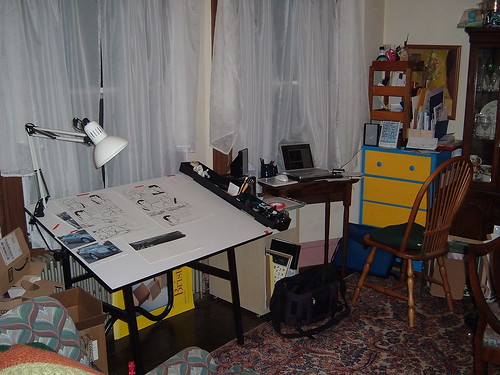Lessons from two SVA alumni:
-Exaulted letterer Todd Klein has a website, with some lettering and design instruction. It covers hand and computer lettering, and even includes a lesson on balloon placement.
-If you didn't think Matt Bernier was insanely dedicated to lettering before, check out this incredible pen hack:

So, to explain what you're seeing a little better:
While sifting through the immense piles of junk left behind by my late grandmother, we occasionally come upon something worth keeping, and one such item was an old fountain pen that my grandfather got for his years of service at Central Maine Power.
As you can see in the picture titled "original configuration", it was a basic plastic fountain pen. The nib is enclosed on the bottom and top by plastic, which the ink creeps down through to supply the nib with ink. The piece securing the bottom of the nib is actually a tapered plug of plastic that fits inside the larger tube that makes up the front of the exterior body of the pen and which hoods over the top of the nib. The inner plug has ink channels which suck up ink into the pen when it is filled. Going further back into the pen, we find a needle thin plastic tube that regulates the flow of ink into the ink chamber created by the gap between the plastic plug and the outer shell. This is to prevent blotting. This tube sticks out of the front section of the pen and into the rubber baggie. The rubber baggie is where the ink goes. Like an organ, it is protected by the outer shell of the back of the pen. On the side of the outer shell is a lever which, when pulled down with your thumbnail, causes a metal foot to squish the little baggie against the side of the pen, squeezing out the ink inside. Releasing the lever allows the bag to re-expand, drawing ink into the pen. This is how filling, or, if you prefer, squirting of the pen is achieved.
Now, I do have specialty fountain pen ink. But it's too thin to make good lines for reproduction, and I wanted to use the pen for lettering. So I put in india ink. It said it was suitable for technical pens, so I figured I'd be okay with clogging. BIG mistake. As I found out, and then later read on every website that discussed fountain pen care, the lacquer base in india ink will seize a pen permanently. But I was unfazed- I've saved brush pens that were clogged, so I figured that a fountain pen could not possibly be as big a challenge.
My first barrier to entry was the bagie, which was glued on. I had to remove it to access the inside of the pen. I carefully loosened it and slipped it off, leaving it to soak in hot water after rinsing it. Then I removed the little tube, using a needle to drive out the solidified ink blocking the way. Then I spent two hours cleaning out all the gunk that had filled the ink chamber. Now it was time to reassemble.
The glues in my house were not suitable to re-seal the baggie, and all my attempts leaked ink. I needed another plan. I was staring at the end, wondering how to stick this crumbly old rubber baggie back on, and then it hit me: the opening looked very close to the size of my brush pen ink cartridge. I thought it might just work, because of the special properties of brush pen ink. The Japanese were the first, and as far as I know, only to have developed waterproof india ink with such finely ground pigment that it won't clog a brush pen. I thought that perhaps it might work in a fountain pen. I grabbed a cartridge to see how they fit. The cartridge was too small. But cartridges taper to get wider at the back; what if I cut the back off and stuck it on that way? I looked like it would just work. Even though it meant losing a cartridge if it failed, I tried it anyway. (I left out the ink regulator, because india ink is thicker, and I'd actually found the pen a little too dry even with wetter ink.) I had to jam it on so the plastic whitened a bit, but it worked. It formed a perfect seal, it drew beautifully, and one week on and it hasn't clogged at all. Furthermore, it's easier to clean, and it refills with cartridges. And the lines are waterproof. The only downside is that I had to lop the back end off the pen to get the cartridge to fit, but an ugly stalk is a small price to pay for the best pimped out pen I've ever used.
-Matt Bernier
According to a NY Times article from a few weeks back, Tony Millionaire uses "store-bought fountain pens he tweaks with a pair of needle-nose pliers." Perhaps hacked fountain pens are the wave of the future?
And while talking to Matt, he gave me the best reason I've ever heard to get as good as you possibly can at lettering: As lettering usually makes up a good third of your page, if your handwriting or lettering sucks, your page sucks by at least 1/3 before you even draw anything. So letter good!
And to round out the day: Achewood on Comic Sans.













